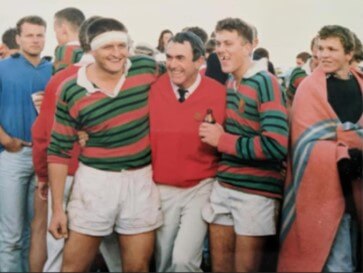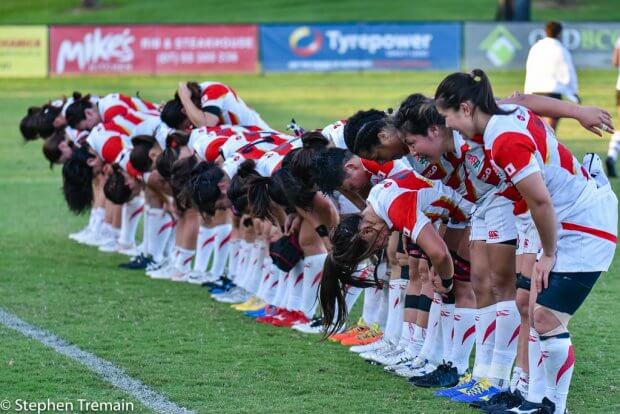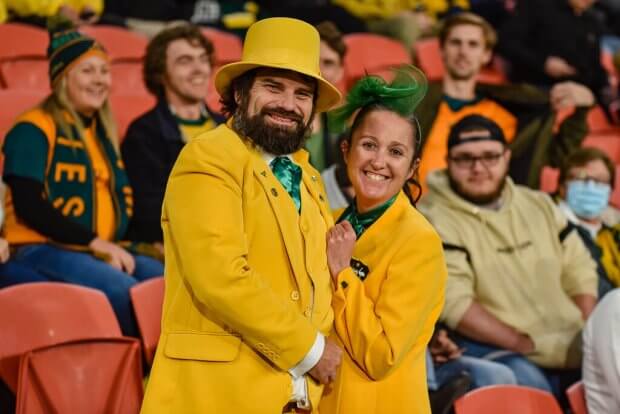Welcome to Thursday’s News, folks. Today’s source of meanderings comes from the desk of AllyOz. Thanks for putting in the time, pal! Still a few more days if anyone else is willing to have a go. Let Sully know (sully@greenandgoldrugby.com) if you’re up for the challenge! Doesn’t have to be smart like Nutta or downright shite like the rest of the craparazzi, anything’s welcome! Keith has been forced into agreed to a second article as well!
Anyhoo, here goes from AllyOz:

Dr Bernard Bindon was my first proper rugby coach. Sadly, Bernie died earlier this year. Bernie excelled as a player, being selected for NSW in 1961 in his last undergraduate year at the University of New England in Armidale, playing centre or five-eighth. He went on to play for NSW again and, later, for Queensland. He was also a brilliant scientist and an internationally renowned animal reproductive biologist.
I only read about Bernie’s playing achievements. The closest I got to watching him play was in our warm-up touch games at training. He was, even in his mid-forties, one of those light stepping, fleet of foot, “there one minute, gone the next” type players. As a slow, lumbering forward I hit air more often than I hit Bernie. While I can’t comment on his playing prowess, I can say that he was arguably one of the finest coaches I ever had the opportunity to play under. And it’s not that I haven’t had exposure to good coaching. Despite my relatively innocuous achievements, I’ve had the opportunity to be coached by Wallabies Tony Darcy, Barry Honan, Damian Frawley and Dave Carter and I’ve also had the chance to observe coaches like Michael Heenan, Stephen Meehan and Billy Millard.
Bernie brought his brilliant scientific mind and his capacity for detailed analysis to his rugby, but he didn’t burden his players with overly complex game plans. Coaching sessions were well structured, basic skills were reinforced but players’ initiative was never curtailed. A genuine laissez-faire spirit was encouraged, well, among the backs at least. The forwards job was to get the backs the ball and to ensure that they kept it.
The game plan was developed to suit the strengths of the team and the club. We were university students with players almost exclusively aged between 17 and 22 years. In a competition that included three other university-based sides and five “adult” or “townie” sides, that gave us a number of distinct advantages and disadvantages. In the forwards, we were generally fitter and faster, but we were always going to lack the sheer strength and power of our opponents. Forwards were simply tasked with securing the ball and delivering it to the backs, keep the 9–10 channel clear and back up and be first to the breakdown. I remember being roundly criticised after scoring three tries in one game because I was “seagulling” in the backs, scoring tries was a backs job. At lineout, scrum, ruck and maul we had to be technically proficient to the highest possible degree because, if we relied on strength and power our physically immaturity would regularly let us down against forward packs of men in their late 20s and early 30s who worked as miners, shearers, farmers, abattoir workers and cattlemen. Maul ball was a risk, so we generally played off the ground, flooded the rucks – bound in pairs where we could – and then swung it as wide as we could. As forwards we ran support lines wide and in numbers – no splitting the forward pack and playing one side or the other. We could win with as little as 30% possession, but we had to be first to the breakdown as we invariably lost the wrestle. We were incredibly well disciplined. We retained possession and ran from anywhere on the field because those teams inevitably had a fullback who could kick 60 yards back into your 22, and once they were camped there, they would suffocate you. They kept the ball in the forwards and manhandled us – it was the highlight of their week to give some self-entitled students a good kicking and a well-deserved dose of humility.
If I try to compare it to any modern side at international level, it was probably most like the Japanese, because, like us, they don’t genetically have those bigger bodies that most teams these days rely on, although they import them much like the rest of us these days.
It helped that we had some very decent players. Our back three for much of the time I attended uni was the Wallaby, Damian Smith, on one wing and Michael Sykes on the other. Michael, after several years of playing for NSW Country, was a long-time member of Northern Suburbs in the Shute Shield and was named Sydney Club Player of the Year in 1998. All of our 10s were natural runners of the ball, they could kick and did so judiciously, but it wasn’t their first instinct. At the back we had a brilliant footballer, Ilya Blazic, who people in the ACT from that time (late 80s, early 90s) might remember. Many of our backs had attended school at places like Joeys, Ashgrove, Nudgee, Riverview and Shore, etc., but there were plenty of us who also attended the local state or Catholic parish schools or country league centres like Woodlawn, Farrer and Yanco. The boys from the GPS schools were extremely well drilled but working with them and coaching staff like Bernie Bindon meant those from other backgrounds soon developed the necessary skills.
And we were supremely fit with a very strong focus on aerobic fitness. Training began three times a week with a five kilometre hill run; all were expected to complete it before training commenced. Almost no one weight trained in those days. Maybe if we had we might not’ve been manhandled so easily but maybe it would have dragged us into competing at a comparative weakness.
In my final year studying I picked up a unit on Trade and Agribusiness Management and we used as a text, a work by Michael Porter called Competitive Advantage. A textbook definition of competitive advantage is, “something that cannot be easily replicated and is exclusive to a company or business. This value is created internally and is what sets the business apart from its competition”. I’m not sure whether Bernie Bindon was aware of the concept but that’s what he had, in fact, instituted across our club. He had developed a style of play that made the most of our strengths and sought to minimise the impact of our competitors’ strengths. Later coaches developed different game plans where we tried to compete more directly with the big forward packs of the “townie” teams, and were less successful.
There are rugby nations where this same concept is in evidence. South Africa have a game clearly defined and developed around their strength: the physical size and power of their forward pack and the speed and strength of their outside backs. They are a side that, as Jesus described the disciple Nathaniel, “in whom there is no deceit.”
Japan, similarly, have crafted a game developed to minimise their size disadvantage based on speed of foot and mind. Their passing game is clinically accurate, they do everything at speed, and they don’t engage opposition forward packs as often as others. I admire their coaches, Joseph and Brown, both NZ born, who haven’t sort to change the natural game of the Japanese but to strengthen it, added a few more layers, but still kept its true nature.
I even sense that Eddie Jones is trying to develop or get back in touch with a uniquely English style, a “bully ball” that conjures in my mind players like Martin Johnson, Lawrence Dallaglio, Brian Moore and Richard Hill. Though he seems to be struggling to marry that with other competing styles of his best players, like the mercurial Marcus Smith.
I am less able to identify anything unique or different about the Australian style of play at the moment and I don’t know if we are tailoring anything to our particular strengths or if we are even conscious of what they are. I don’t see this as a recent thing that has occurred under Dave Rennie. I feel we’ve been drifting now for years, trying to copy or adapt something from outside. It feels a bit like wearing a jacket handed down from your big brother. While I think competing closely with New Zealand teams is part of what will help us succeed in the future, I think there are things about our game, our culture (rugby and otherwise) and the way the game has developed in Australia that are unique. Copy the NZ way, just because we’re playing against them, could be a big mistake.
There are not the same kind of physical differences that, for instance, Japan have between our players and those from New Zealand. We draw our players from, to a greater or lesser extent, similar genetic pools. A mix of Anglo-Celtic and Melanesian/Polynesian islanders dominate. We may have access to a greater number of Australian aboriginal peoples perhaps, though we have never particularly been able to attract players with that background away from other sports in any great numbers.
The differences are perhaps subtle and more psychological than physical. Most Aussie kids will see other sports played more often and have experience of Aussie Rules or rugby league. I suspect we play more touch footy at training and in the park and the school yard than in other countries. We also have a history of a running game and one that is played differently to the way NZ play with ball in hand. For mine, our natural game is a little more open, a little more risk tolerant, more likely to chase a try than others. Our weather, particularly in Queensland, NSW and WA, is also a point of difference: we have more dry weather than other rugby nations so we should be more suited to playing an expansive, less kick-orientated, ball-in-hand game; one that, while still needing to go forward, is less frightened than some to go wide. It’s also a style that attracts our crowds, whether they were the fans of the tricks and flicks of Quade Cooper or the pass and support play of Mark Ella.
I think we are also less “brutal” than our opponents, a word that I’ve heard often from both our current and our previous head coach. Ironically, I preferred to play the more collision-based country rugby of the “townie” teams later in my playing days than the game I played as a student. Australia certainly has players who are suited to that bash ‘em up style. But I feel the natural Australian game relies less on brutality and more on clever use of the ball. We shouldn’t allow ourselves to be bullied but that doesn’t mean that brutality is part of our competitive advantage, not like it is for South Africa, England, the British Lions or France.
Adapting our game to a northern hemisphere style because that is where the next World Cup would be a mistake, particularly given that only one northern hemisphere team has ever won a World Cup and, ironically, it was one that was held in the south. Similarly, trying to play like the sides we come up against in SR Pacific or playing like the All Blacks won’t necessarily see us advance our play.
We’re suffering from an identity crisis. We’ve been trying for years to win by being something we aren’t, by playing styles suited to what’s worked for others and that don’t necessarily fit with our natural abilities or our own character. Rugby in Australia has a certain feel and rhythm to it, and we need to get back in touch with that. That doesn’t rule out foreign coaches, and it shouldn’t mean our provincial sides all play a cookie cutter style, there’s plenty of room for variation. I’m not suggesting either that Australia adopt the Bernie Bindon style of student rugby that he coached so brilliantly. That was fit for our strengths and limitations, Australia’s are different. But we should have the courage to rediscover and develop a unique Australian way and to play our game not just copy or adapt what works for others.



